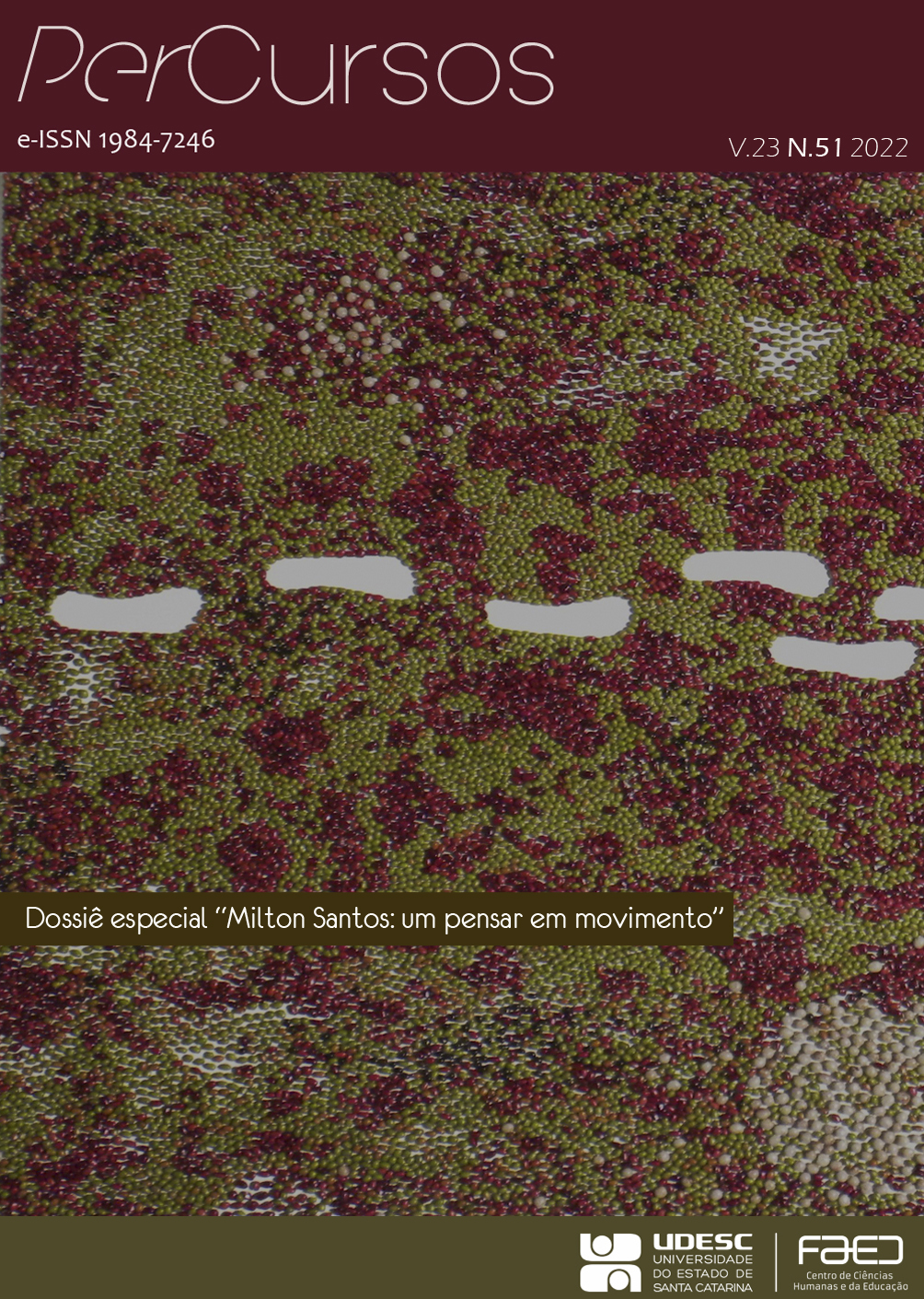The teaching-learning of geography in the context of the technical-scientific-informational revolution: analysis on the possibilities of using Google Earth Pro
DOI:
https://doi.org/10.5965/1984724623512022364Keywords:
teaching-learning of geography, TDIC, Google Earth ProAbstract
Since the second half of the twentieth century, with the Technical-Scientific-Informational Revolution, the production of geographic space has been increasingly characterized by the uses of science, information, consumption and finance. In Education, the teaching-learning process is marked by digital information and communication technologies (TDIC). Therefore, the teacher should not neglect the fact that TDIC are part of the student's daily life and, thus, can be used as strategies for the amplification of learning in the wake of the student's prominence as a protagonist of the educational process. For this, it is necessary that teachers know cyberculture and participate in it, including in their professional practice the use of TDIC, considering the availability ofinfrastructural and socioeconomic possibilities of the school and the community involved in the educational process. For the teaching-learning of Geography in Basic Education, specifically in Elementary School II, we believe that the uses of TDIC can mean methodological strategies for the understanding of contents that are fundamental to the understanding of the dynamics of geographical spacewith regard to various geographic scales. Among these contents, we highlight that of cartographic literacy, which is the learning of notions of location, organization and representation of geographical space, as a product and condition of human actions and social relations. Therefore, in this work we aim to analyze the possibilities of using the Google Earth Pro software for teaching-learning Geography in Elementary School II, especially regarding the understanding of the cartographic representation of geographic space. We conclude that, for teaching-learning Geography, this software can be an important didactic-pedagogical tool, useful for the development of a dynamic, active and contextualized educational process with regard to contents such as the (re)production of geographical space and that of cartographic language.
Downloads
References
BARRETO, Aldo de Albuquerque. Informação e transferência de tecnologia: mecanismos e absorção de novas tecnologias. Brasília: IICT, 1992.
BALBINO, Jaime. Objetos de aprendizagem: contribuições para a sua genealogia. Educação e Tecnologia, Curitiba, p. 01-10, abr. 2007.
BRASIL. Instituto Nacional de Estudos e Pesquisas Educacionais Anísio Teixeira. Censo escolar de 2018: notas estatísticas 2018. [S.l.], 2018. Disponível em: http://download.inep.gov.br/educacao_basica/censo_escolar/notas_estatisticas/2018/notas_estatisticas_censo_escolar_2018.pdf. Acesso em: 04 mar. 2019.
CAVALCANTI, Lana de Souza. Geografia, escola e construção de conhecimentos. 17. ed. Campinas: Papirus, 1998.
CASTROGIOVANNI, Antônio Carlos; CALLAI, Helena Copetti; KAERCHER, Nestor André. Ensino de geografia: práticas e textualizações no cotidiano. Porto Alegre: Editora Mediação, 2008.
CASTRO, Iná Elias de. O problema da escala. In: CASTRO, Iná Elias de; GOMES, Paulo César da Costa; CORRÊA, Roberto Lobato (org.) Geografia: conceitos e temas. Rio de Janeiro, Bertrand, 1995. p. 117-140.
FERREIRA, William D.; LINO, Natalia Cristina; CARDOSO, Murilo Raphael Dias. Google Earth. [S.l.], 2021. Disponível em: http://www.mp.go.gov.br/portalweb/hp/10/docs/apostila_-_google_earth_-_mp-go.pdf. Acesso em: 17 dez. 2018.
GIL, Antônio Carlos. Como elaborar projetos de pesquisa. 4. ed. São Paulo: Atlas, 2002.
GOOGLE Earth Pro website: versão 1.3.33.23. [S.l.]: Microsoft Corparation, 2007. Disponível em: https://www.google.com/intl/pt-BR_ALL/earth/. Acesso em: 12 ago. 2018.
GUERRERO, Ana Lúcia de Araújo. Alfabetização e letramento cartográfico na geografia escolar. São Paulo: Edições SM, 2012.
KENSKI, Vani Moreira. Tecnologias e ensino presencial e a distância. Campinas: Papirus, 2004.
KENSKI, Vani Moreira. Educação e tecnologias: o novo ritmo da informação. 2. ed. Campinas: Papirus, 2007.
MORAN, José Manuel; MASETTO, Marcos T.; BEHRENS, Marilda Aparecida. Novas tecnologias e mediação pedagógica. 10. ed. Campinas: Papirus, 2000.
MOURA, Leda Maria Corrêa. Uso de linguagem cartográfica no ensino de geografia: os mapas e atlas digitais na sala de aula. [S.l.], 2010. Disponível em: http://www.educadores.diaadia.pr.gov.br/arquivos/File/2010/artigos_teses/2010/Geo grafia/cartografia/uso_atlas_google.pdf. Acesso em: 14 maio 2021.
PASSINI, Elza Yasuko. Alfabetização cartográfica e a aprendizagem de geografia. São Paulo: Cortez, 2012.
SANCHO, Juana María. De tecnologias da informação e comunicação a recursos educativos. In: SANCHO, Juana María et al. Tecnologias para transformar a educação. Tradução de Valério Campos. Porto Alegre: Artmed, 2006. p. 14-34.
SANTOS, Milton. Técnica, espaço, tempo: globalização e meio técnico-científico informacional. São Paulo: Hucitec, 1994.
SILVA, Claci Clair Röpke da; PORTO, Marcelo Duarte; MEDEIROS, Wilton de Araújo. A teoria vygotskyana e a utilização das novas tecnologias no ensino aprendizagem: uma reflexão sobre o uso do celular. Revista online de Magistro de Filosofia, Anápolis, ano X, n. 21, p. 84-98, 1 sem. 2017.
SILVEIRA, Denise Tolfo; CÓRDAVO, Fernanda Peixoto. A pesquisa científica. In: GERHARDT, Tatiana Engel; SILVEIRA, Denise Tolfo (org.). Métodos de pesquisa. Porto Alegre: Editora da UFRGS, 2009. p. 31-42
SILVEIRA, María Laura. Finanças, consumo e circuitos da economia urbana na cidade de São Paulo. Caderno CRH (UFBA), Salvador, v. 22, p. 65-76, 2009. DOI: https://doi.org/10.1590/S0103-49792009000100004
Downloads
Published
How to Cite
Issue
Section
License
Copyright (c) 2022 PerCursos

This work is licensed under a Creative Commons Attribution-NonCommercial-NoDerivatives 4.0 International License.


